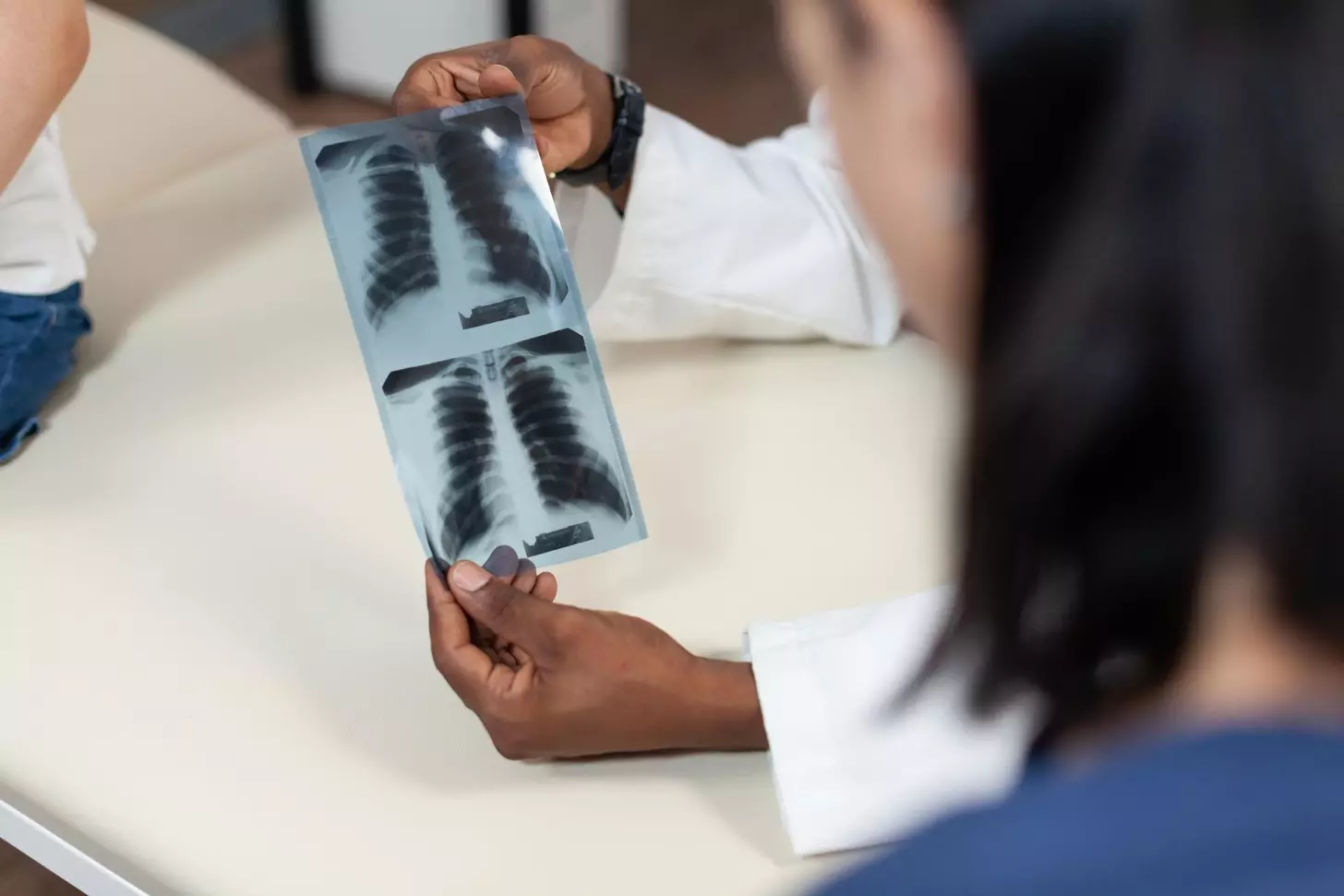Last Updated on November 26, 2025 by Bilal Hasdemir

Advances in treating squamous cell carcinoma lung cancer have greatly improved patient results. At Liv Hospital, we offer detailed care for international patients. We use the newest treatments and medical methods.
Thanks to modern treatments, patients with metastatic squamous NSCLC can now live over a year. Our treatments include immunotherapy, targeted therapies, and chemotherapy. We also use surgery and radiation for cancers that are in one place.
We know how important a treatment plan that fits you is. We work closely with our patients to find the best treatment. Our goal is to give you the best healthcare possible, with a focus on you.
Key Takeaways
- Modern therapies have improved survival rates for squamous cell carcinoma lung cancer.
- Treatment options include immunotherapy, targeted therapies, and chemotherapy.
- Surgery and radiation are effective for localized disease.
- Personalized treatment plans are key for the best results.
- Liv Hospital offers detailed care for international patients.
Understanding Lung Epidermoid Carcinoma: Classification and Prevalence
Lung epidermoid carcinoma, also known as squamous cell carcinoma of the lung, is a major type of non-small cell lung cancer (NSCLC). It affects many people worldwide. This cancer starts in the squamous cells, which line the airways in the lungs.
What is Squamous Cell Carcinoma of the Lung?
Squamous cell carcinoma of the lung comes from squamous cells. It’s a key subtype of NSCLC, the most common lung cancer. We’ll look at its unique features and how it differs from other lung cancers.
Studies show a strong link between smoking and squamous cell carcinoma. The connection between smoking and squamous cell is clear. Quitting smoking is key to lowering the risk of this cancer.
Prevalence and Risk Factors
Lung epidermoid carcinoma makes up about 20–30% of NSCLC cases. It’s a big concern for health worldwide. The cancer’s prevalence varies by region, with more cases in areas where smoking is common.
Factors that increase the risk of squamous cell carcinoma of the lung include:
- Smoking: The biggest risk factor, with a clear link to dose.
- Exposure to carcinogens: Like asbestos, arsenic, and certain chemicals.
- Previous radiation therapy: To the chest area.
- Genetic predisposition: Some genetic mutations raise the risk.
| Risk Factor | Description | Relative Risk |
|---|---|---|
| Smoking | Active and passive smoking | High |
| Asbestos Exposure | Occupational exposure to asbestos | Moderate to High |
| Radiation Therapy | Previous radiation to the chest | Moderate |
Distinguishing NSCLC Squamous from Other Lung Cancers
NSCLC squamous cell carcinoma is different from other lung cancers based on its look and molecular profile. Knowing this is key for choosing the right treatment.
Experts say, “The way we classify lung cancer has changed a lot. Now, we focus more on molecular traits for targeted treatments.” This shows how important accurate diagnosis is for effective lung cancer management.
“The accurate diagnosis of NSCLC subtypes, including squamous cell carcinoma, is critical for selecting the most appropriate treatment regimen and improving patient outcomes.”
Understanding lung epidermoid carcinoma is vital for diagnosis and treatment planning. By knowing its prevalence, risk factors, and unique traits, doctors can give patients more tailored and effective care.
Diagnosis and Staging: Critical First Steps
Getting a correct diagnosis and staging is key to finding the right treatment for squamous cell carcinoma lung cancer. We use different tests to make sure we know exactly what we’re dealing with and how far it has spread.
Diagnostic Procedures and Molecular Profiling
To find squamous cell carcinoma lung cancer, we use CT scans and PET scans. These help us see the main tumor and if it has spread. A biopsy is also needed to get tissue for tests.
Molecular profiling is very important in lung cancer diagnosis. It helps us find specific genetic changes that can help choose the right treatment. For squamous cell carcinoma, we check for PD-L1 to see if immunotherapy is an option.
Staging Systems and Their Impact on Treatment Selection
We use the TNM staging system for non-small cell lung cancer, including squamous cell carcinoma. This system looks at the tumor size, lymph node involvement, and if it has spread.
| TNM Stage | Description | Typical Treatment Approach |
|---|---|---|
| I | Localized tumor | Surgery or Stereotactic Body Radiation Therapy (SBRT) |
| II | Larger tumor or limited lymph node involvement | Surgery followed by adjuvant therapy |
| III | Extensive lymph node involvement | Multimodal treatment including chemotherapy and radiation |
| IV | Distant metastasis | Systemic therapy such as chemotherapy or immunotherapy |
The Rare Case of Small Cell Squamous Cell Lung Cancer
Squamous cell carcinoma is a type of NSCLC, but there’s a rare and aggressive form called small cell lung cancer (SCLC). When SCLC and squamous cell carcinoma combine, it’s very rare and very challenging to diagnose and treat.
It’s vital to understand the diagnosis and staging to plan the best treatment. Advances in molecular profiling are helping us find new ways to treat SCC lung cancer, giving patients new hope.
Surgical Interventions for Localized Disease
For patients with localized squamous cell lung cancer, surgery is a key treatment. We will look at the different surgical methods, who is a good candidate, and post-surgery care.
Types of Surgical Procedures
Surgical removal is the main treatment for early-stage squamous cell lung cancer. The surgery type depends on the tumor’s size, location, and the patient’s health.
- Lobectomy: Removing the tumor-containing lobe is the standard for early-stage disease.
- Sublobar Resection: Smaller tumors or those in patients with limited lung function may get segmentectomy or wedge resection.
- Pneumonectomy: Removing the whole lung is usually for larger tumors or those affecting major airways.
Minimally invasive surgeries like VATS and robotic-assisted surgery are becoming more common. They help reduce recovery time and complications.
Patient Selection Criteria
Choosing the right patients for surgery is key. We consider the cancer stage, lung function, overall health, and patient preferences.
| Criteria | Description |
|---|---|
| Tumor Stage | Early-stage disease (Stage I and II) is typically considered for surgical resection. |
| Pulmonary Function | Patients must have sufficient lung function to tolerate the surgery. |
| Overall Health | Comorbidities and performance status are evaluated to assess surgical risk. |
Post-Surgical Management and Outcomes
After surgery, patients are watched for complications and managed as needed. Adjuvant therapies may be suggested based on pathology.
Outcomes after surgery vary by stage and patient health. Generally, those with early-stage disease have a better outlook.
- Surveillance: Regular follow-up with imaging studies to monitor for recurrence.
- Adjuvant Therapy: Chemotherapy or radiation therapy may be recommended to reduce the risk of recurrence.
By carefully choosing patients and using the right surgical methods, we can improve outcomes for those with localized squamous cell lung cancer.
Radiation Therapy: Targeted Treatment Approaches
Radiation therapy is a key part of treating squamous cell carcinoma lung cancer. It offers targeted ways to fight the disease. We use it at different stages of treatment, alone or with other therapies.
External Beam Radiation Techniques
External beam radiation therapy (EBRT) is a common method for treating squamous cell carcinoma lung cancer. It uses high-energy beams from outside the body to kill cancer cells. We use advanced tech to make sure the radiation hits the right spot, protecting healthy tissues.
EBRT has improved with new tech, making it more precise. Techniques like 3D-CRT and IMRT let us shape the radiation to fit the tumor. This makes treatment more effective.
Stereotactic Body Radiation Therapy (SBRT)
Stereotactic Body Radiation Therapy (SBRT) is used for early-stage lung cancer or when surgery isn’t possible. It gives high doses of radiation in a few sessions, focusing on the tumor and sparing other tissue.
SBRT works well for small, localized tumors. It’s non-invasive and has a shorter treatment time. This makes it a good choice for patients who can’t have traditional surgery.
Radiation as Adjuvant or Palliative Treatment
Radiation therapy is also used after surgery to kill any remaining cancer cells. This lowers the chance of the cancer coming back. It’s also used to ease symptoms like pain, cough, or breathing trouble in advanced lung cancer.
In advanced cases, radiation therapy can greatly improve a patient’s quality of life. It helps control symptoms and reduces the disease’s impact.
| Treatment Approach | Description | Benefits |
|---|---|---|
| External Beam Radiation Therapy (EBRT) | High-energy beams target cancer cells from outside the body | Precise delivery, minimizes damage to healthy tissues |
| Stereotactic Body Radiation Therapy (SBRT) | High doses of radiation in few fractions, precise targeting | Effective for early-stage lung cancer, non-invasive |
| Adjuvant Radiation Therapy | Post-surgery radiation to eliminate remaining cancer cells | Reduces risk of recurrence |
| Palliative Radiation Therapy | Relieves symptoms in advanced lung cancer | Improves quality of life |
Platinum-Based Chemotherapy Regimens
Platinum-based chemotherapy is key in treating squamous cell carcinoma lung cancer. It targets fast-growing cancer cells effectively.
First-Line and Second-Line Protocols
For advanced squamous cell carcinoma, platinum-based chemotherapy is often the first choice. Common treatments include cisplatin or carboplatin with docetaxel or gemcitabine. When the disease gets worse, second-line treatments are used. These might include different platinum compounds or new agents.
“Choosing between cisplatin and carboplatin depends on the patient’s health and how well they can handle side effects,” a study on NSCLC treatment protocols explains.
Combination Strategies with Other Agents
Adding other treatments to platinum-based chemotherapy can improve results. For example, combining it with immunotherapy or targeted therapy can lead to better survival rates and response.
- Platinum + pemetrexed
- Platinum + gemcitabine
- Platinum + docetaxel
These combinations are chosen based on the patient’s needs and the tumor’s characteristics.
Managing Toxicity and Side Effects
It’s important to manage the side effects of platinum-based chemotherapy. Common issues include nausea, fatigue, and low blood counts. We use antiemetic drugs and adjust doses to help.
“Managing chemotherapy side effects is vital for keeping patients’ quality of life high and ensuring they stick to their treatment plans.”
By weighing the benefits and risks of platinum-based chemotherapy, we aim to get the best results for patients with squamous cell carcinoma lung cancer.
Immunotherapy: Checkpoint Inhibitors Transforming SCC Lung Treatment
Immunotherapy has changed how we treat squamous cell carcinoma (SCC) of the lung. It’s a big shift, with checkpoint inhibitors leading the way.
PD-1/PD-L1 Inhibitors and Their Mechanism
PD-1/PD-L1 inhibitors are key in fighting SCC lung cancer. They block the PD-1 receptor on T cells and PD-L1 on tumor cells. This lets the immune system attack cancer cells better.
These drugs work by activating T cells to destroy cancer cells. Clinical trials show they improve response rates and survival for advanced SCC lung cancer patients.
Biomarker Testing for Patient Selection
The success of PD-1/PD-L1 inhibitors depends on biomarkers. Testing for PD-L1 expression is vital for choosing the right patients. It helps predict who will respond well to these treatments.
Other biomarkers like tumor mutational burden (TMB) are also being studied. This helps tailor treatments for SCC lung cancer more effectively.
| Biomarker | Significance in SCC Lung Cancer |
|---|---|
| PD-L1 Expression | Predicts response to PD-1/PD-L1 inhibitors |
| Tumor Mutational Burden (TMB) | Potential predictor of immunotherapy response |
| Other Genetic Alterations | Emerging targets for novel therapies |
Response Patterns and Long-Term Outcomes
Reactions to PD-1/PD-L1 inhibitors in SCC lung cancer vary. Some see quick and lasting results, while others have slower or less dramatic responses. Those who do respond often enjoy long-term benefits, staying on treatment for a long time.
Studies show some patients live much longer, and in rare cases, might even be cured. Researchers are working to understand why responses differ and how to make immunotherapy more effective.
Targeted Therapies for Molecular Alterations
For patients with squamous cell carcinoma of the lung, targeted therapies offer a promising treatment avenue. They address specific molecular changes. These therapies target particular genetic mutations or alterations that drive cancer cell growth and spread.
EGFR-Directed Treatments
Epidermal Growth Factor Receptor (EGFR) mutations are common in NSCLC, including squamous cell carcinoma. EGFR-directed treatments have shown significant efficacy in patients with EGFR-mutated tumors. These treatments inhibit the EGFR tyrosine kinase activity, blocking signaling pathways that promote tumor growth.
Several EGFR inhibitors are available, including first-generation (e.g., erlotinib), second-generation (e.g., afatinib), and third-generation (e.g., osimertinib) agents. The choice of EGFR inhibitor depends on the specific mutation profile and previous treatments.
Other Actionable Mutations in Squamous NSCLC
Beyond EGFR mutations, other genetic alterations in squamous NSCLC are being targeted with specific therapies. For instance, FGFR alterations are found in a subset of squamous NSCLC patients, and FGFR inhibitors are being explored as treatments. Similar to this, PIK3CA mutations are targeted with PI3K inhibitors.
| Mutation | Targeted Therapy | Clinical Status |
|---|---|---|
| EGFR | EGFR inhibitors (erlotinib, afatinib, osimertinib) | Approved |
| FGFR | FGFR inhibitors | Investigational |
| PIK3CA | PI3K inhibitors | Investigational |
Overcoming Resistance Mechanisms
Despite the initial success of targeted therapies, resistance often develops, limiting their long-term efficacy. Resistance mechanisms can include secondary mutations in the target gene, activation of alternative signaling pathways, or other molecular changes.
Strategies to overcome resistance include developing next-generation inhibitors that can target resistant clones. Combination regimens that block multiple pathways simultaneously are also used. Novel therapies that target resistance mechanisms directly are being explored.
Emerging Treatments for Metastatic Squamous Cell Lung Cancer
New treatments are being developed for metastatic squamous cell lung cancer. These include immunotherapy and targeted therapies. They offer hope for patients.
Bispecific Antibodies and Novel Immunotherapies
Bispecific antibodies are a new type of immunotherapy. They can bind to two targets at once. This helps the immune system fight cancer cells better. Clinical trials are checking if they work well for this cancer.
Other new treatments include checkpoint inhibitors and cancer vaccines. They aim to boost the immune system’s fight against cancer. Developing these treatments is complex and requires careful patient care.
Antibody-Drug Conjugates
Antibody-drug conjugates (ADCs) are another new treatment. They combine antibodies with small molecule drugs. This targets cancer cells while protecting healthy tissues.
ADCs work by linking an antibody to a drug with a special linker. This ensures the drug is released near the tumor. This makes the treatment more effective.
Innovative Combination Approaches
New ways to mix treatments are being tried. Mixing immunotherapy with other treatments might work better. Researchers are finding the best combinations and orders.
The treatment options for metastatic squamous cell lung cancer are growing. Thanks to these new treatments, patients may see better results. As research goes on, we expect even more progress.
Multidisciplinary Approach to NSCLC Squamous Cell Carcinoma
NSCLC squamous cell carcinoma is complex and needs a team effort for treatment. This team includes many healthcare experts working together. They aim to give patients the best care possible.
Tumor Board Evaluations
Tumor board evaluations are key in managing NSCLC squamous cell carcinoma. Specialists from oncology, radiology, pathology, and surgery come together. They discuss patient cases and plan treatments.
“Collaboration is key in managing complex cases of NSCLC squamous cell carcinoma.” Tumor boards make sure all important information is shared. They choose the best treatment plans for each patient.
Integrating Multiple Treatment Modalities
Using different treatments together is important for patients with NSCLC squamous cell carcinoma. This might include surgery, radiation, chemotherapy, targeted therapy, and immunotherapy.
- Combining treatments to address both local and systemic disease
- Using neoadjuvant therapy to shrink tumors before surgery
- Implementing adjuvant therapy to reduce the risk of recurrence
By mixing these treatments, we can make plans that fit each patient’s needs. This improves their outcomes and quality of life.
Personalized Treatment Planning
Personalized treatment planning is central to managing NSCLC squamous cell carcinoma. We look at each patient’s tumor, health, and preferences. This helps us create targeted treatment plans.
“The future of cancer treatment is personalized medicine, where therapies are tailored to the individual characteristics of each patient’s tumor.”
Advanced tests like molecular profiling and genetic testing help us find specific biomarkers. This lets us make treatment plans that meet each patient’s unique needs.
Conclusion: Advances in Squamous Cell Lung Cancer Management and Future Directions
Recent breakthroughs in molecular profiling and immunotherapy have changed how we treat non-small cell lung cancer (NSCLC). This is true for squamous cell carcinoma in particular. Now, treatments are more tailored to each patient, focusing on specific genetic changes and using the immune system to combat cancer.
Combining different treatments like surgery, radiation, and systemic therapies has made care better for patients. New treatments, like bispecific antibodies and antibody-drug conjugates, are being tested in trials. They show great promise for the future of NSCLC treatment.
Looking ahead, we need to keep innovating and provide complete care to improve patient results. The future of lung cancer treatment is in making therapies fit each patient’s unique genetic makeup and health situation. By deepening our knowledge of NSCLC and creating more effective treatments, we can boost survival rates and enhance the quality of life for those with squamous cell lung cancer.
FAQ
What is squamous cell carcinoma of the lung?
Squamous cell carcinoma of the lung is a type of lung cancer. It starts in the squamous cells. These cells line the airways in the lungs.
What are the risk factors for developing squamous cell carcinoma of the lung?
Risk factors include smoking and exposure to harmful substances like asbestos and radon. A history of lung disease also increases the risk.
How is squamous cell carcinoma of the lung diagnosed?
Diagnosis uses imaging tests like CT scans and biopsy procedures. These help examine tissue samples for cancer cells.
What is the role of molecular profiling in treating squamous cell carcinoma of the lung?
Molecular profiling identifies genetic mutations in cancer cells. It helps choose targeted therapies and guides treatment decisions.
What are the treatment options for localized squamous cell carcinoma of the lung?
Localized disease may be treated with surgery, radiation, or both. The choice depends on the stage and patient factors.
How does immunotherapy work in treating squamous cell carcinoma of the lung?
Immunotherapy, like PD-1/PD-L1 inhibitors, boosts the immune system. It helps the immune system attack cancer cells more effectively.
What are the emerging treatments for metastatic squamous cell lung cancer?
New treatments include bispecific antibodies and novel immunotherapies. They are being tested in clinical trials to improve outcomes.
Why is a multidisciplinary approach important in treating NSCLC squamous cell carcinoma?
A team approach ensures complete care. It allows for the use of various treatments to create personalized plans.
What is the significance of tumor board evaluations in managing squamous cell carcinoma of the lung?
Tumor board evaluations involve experts discussing individual cases. They recommend the best treatment based on the latest evidence and guidelines.
How do targeted therapies work in treating squamous cell carcinoma of the lung with specific molecular alterations?
Targeted therapies target specific molecular changes. They offer a tailored approach to treating cancer, like EGFR mutations
Reference
National Cancer Institute (NCI). Non-Small Cell Lung Cancer Treatment (PDQ). https://www.cancer.gov/types/lung/patient/non-small-cell-lung-treatment-pdq
NCBI. PMC article. https://pmc.ncbi.nlm.nih.gov/articles/PMC11937135/
Cancer Research Institute (CRI). Immunotherapy for Lung Cancer. https://www.cancerresearch.org/immunotherapy-by-cancer-type/lung-cancer








